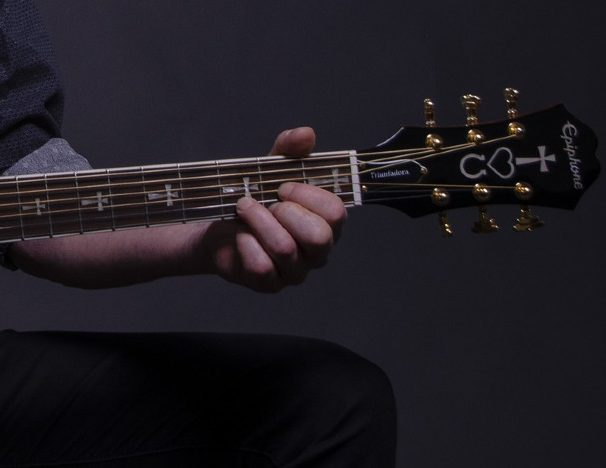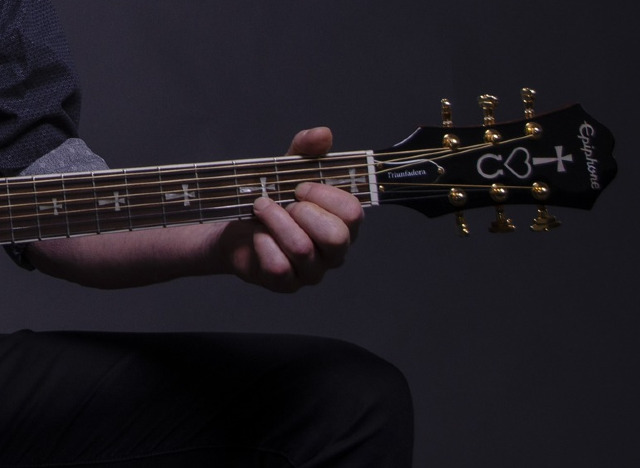
I’ll make a bold statement. One could make the argument for open chords as the most important concept to understand in playing guitar. Guitar playing just wouldn’t be as accessible to all of us without them. Let’s talk in some detail about open chords.
What are open chords?
On the guitar, open chords are combinations of three or more strings that form a chord while using one or more of the strings in open position. For example, an open chord might use two notes that require fretting, while a third does not. That third string is said to be open (since you don’t put a finger on it) and makes the chord an open chord. The most typical open chords are usually played by fretting the strings within the first four frets while letting one or more strings ring open.
Open chords often get a bad reputation because they’re often seen as simplistic and unsophisticated. Yet, many of your favorite songs and famous recordings use open chords, and they are an indispensable part of guitar playing.
Open chords are more typically used when playing an acoustic guitar, but electric guitar players also often make use of them. You will hear them used in virtually any style of guitar music, and they’re especially prevalent in folk, country, rock, singer/songwriter, and similar genres.
Five critical major open chords
Open versions of all types of chords exist. This includes major, minor, sevenths, diminished, suspended, and many others.
For beginning guitarists, it’s very useful to learn five critical major chords in the open position. Those chords are A, C, D, E, and G.
With just those five chords you can play thousands of different songs on guitar. So let’s take a look at them now.
I’ve talked about simple versions of each of these five major open chords in
It’s easier than you think to learn how to play a chord on guitar
It might be a good idea for you to read that article before you continue with this one!
You’ll find that open chords can be a bit difficult to play at first. Since the shapes typically require more strings than their simple forms, it will be difficult for you to make these chords at first. That’s perfectly normal and expected! So don’t lose heart. Keep working at it and soon these shapes will become second nature to you.
D Major open chord
I’m going to start with the D major chord because if you’ve already read the article I mention above, then you already know this shape. Since there really is not simplified form of the D chord, in that article I taught you the complete open D chord.
For this chord you use the three thinnest strings, fretting each of them appropriately. You also play the open D string as the bass note of this chord. That open D string makes this chord shape an open chord.
The D major chord includes the notes D, A, and F#. So we need an open shape that includes these three notes.
It’s helpful to understand the recipes for chords
To play the open D chord, press the G string at fret 2 with your index finger for the note A. With your middle finger, press fret 2 of the High E string for the note F#. Press fret 3 of the B string with your ring finger for the note D. And finally, leave the D string open. Notice this open shape features two D notes.
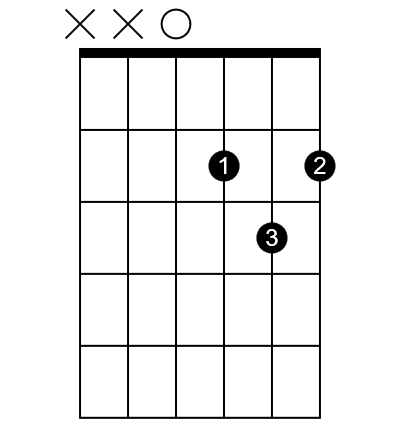
Remember not to strum the Low E string or the A string. The note E does not belong in the chord. And while technically the note A does belong in the chord, A as the bass note does not sound great with the open D chord except in specific situations. Usually you’ll want to omit it.
It will be difficult for you at first to avoid hitting those two low strings with your pick as you strum, but you really need to work at it. It’s important not to play those notes or the chord just won’t sound right.
You will find the D major open chord extremely prevalent in songs written in the key of D. Of course, in the key of D, the D major chord serves as the one chord and usually the most important chord. You will also find the chord D in songs written in the key of A where it serves as the four chord. And finally, you’ll see it in the key of G where it serves as the five chord.
A Major open chord
To play the A major chord, you need the notes A, C#, and E.
The A major open chord, while conceptually one of the simplest shapes since all the fretted notes exist in one fret, can be difficult to play. That’s because the fingering shape that I recommend turns out to be a bit of a finger twister.
But I recommend this shape for good reasons. It’s not only important to know how to make each of these chords. It’s equally as important to learn how to move from one of these chords to the others. Especially others that exist in the same key and get used frequently together in the same song.
This fingering for the A major chord might be tricky at first, but it makes it much easier to move to related chords. And once you get used to this shape, you won’t even think about it any more. It will quickly stop being complicated or difficult for you. You simply have to break through and get comfortable with it.
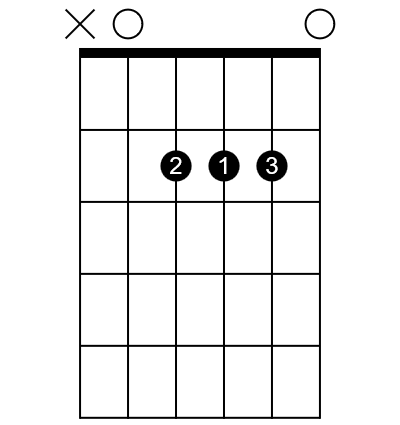
To play this chord, leave the A string and the High E string open. Then, first press fret 2 of the G string with your pointer for an A note. Then reach around your pointer with your middle finger to press fret 2 of the D string for an E note. Finally, slide your ring finger in and play fret 2 of the B string for a C#.
Notice how fingers 2 and 3 sort of surround finger 1. It feels odd at first and it will certainly take you some time to get used to. But this fingering is really great for a couple of reasons.
First, notice that your pointer sits at fret 2 of the G string. That’s the same A note that you needed in the open D Major chord I talk about above. And and you play that note with the same finger in both chords.
You’ll very often move from this A chord to that D chord and back. So this fingering makes the switch easier since you only have to move two fingers and your pointer can act as sort of an anchor to keep you in the right place during the switch.
Another great thing about this fingering serves those of us with somewhat fatter fingers. With this fingering you can more easily squeeze three chubby fingers into the one single fret.
This open A chord uses five of the six strings, so it’s a nice, strong-sounding chord. Notice that it has both two A notes and two E notes. Similar to the D chord, although the Low E string technically could be used with the A major chord, it only sounds good in specific situations, so you’ll want to leave it out most of the time.
You’ll use the A chord in the key of A where it’s the root. You’ll also use it often in the key of E where it’s the four chord and as mentioned above, in the key of D where it’s the five.
E Major open chord
To play E major you need the notes E, B, and G#.
Few–if any–chords on the guitar supersede the E open chord as the most important chord shape on the guitar. You’ll learn later just how versatile this shape can be. You will use it very often in all genres of music because it forms the basic shape of all major bar (barre) chords.
Notice that this shape uses all six strings including the lowest note on the guitar and three open strings. Because of these facts, the open E major chord sounds full, powerful, and rich. It’s a great chord for making an impactful statement.

To play the open E chord, leave the Low E, the B, and the High E strings open.
Play the G# note at fret 1 of the G string with your pointer finger. Note that to move between the chords A and E you only need slide that pointer up or down one fret.
And if you’re in the key of A, that pointer never moves from the G string as it plays through the A, D, and E chords, which happens quite often in that key.
With your pointer on fret 1 of the G string, press fret 2 of the A string with your middle finger. Finally, press fret 2 of the D string with your ring finger.
With this chord you have three E notes and two B notes.
Since this chord uses all six strings, feel free to hit all of them. But don’t forget to play with dynamics, or this chord can become overpowering. You’ll find tons of blues songs in the key of E, so this chord is super popular in the blues and early rock and roll songs.
C Major open chord
To make a C Major chord you need the notes C, E, and G.
The C chord is another massively popular chord. Folk and country songs sound great with it, so you’ll see it in those genres quite often. More advanced players can build very interesting finger-style picking patterns off of the C chord shape, so it becomes very powerful in the finger-stye world.
It also turns out to be one of the most natural-feeling and comfortable chords to play, so you’ll learn it quickly and enjoy using it.

To play the C major open chord, leave the G and High E strings open.
Press fret 1 of the B string with your pointer for a C note. Press fret 2 of the D string with your middle finger for an E note. Finally, press fret 3 of the A string with your ring finger for another C note.
Again, while the Low E technically fits as part of the C chord, it doesn’t sound great to play it, so leave it out.
Notice that this five-string chord features two C notes and two E notes. It’s another chord that sound quite full.
In addition to the key of C where this is the root chord, you’ll find the C chord in songs written in the key of G.
G Major open chord
To make a G Major chord you need the notes G, B, and D.
The G major open chord rules in the bluegrass genre, but you’ll find it in pretty much every other genre too. Since it uses all six strings, it’s another powerful and full chord.
It’s also easy to play. Since to play it you need to reach across all six strings, it’s a comfortable shape to get to and hold. If you have very small hands, you might have a bit of trouble with it, but I’ve never come across anyone who can’t play it.
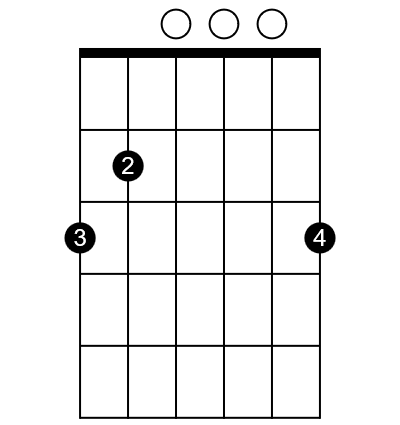
To make the G chord, leave the D, G, and B strings open. For the fingering of the frets, there seems to be two approaches. The probably more common of the two uses the pointer, middle, and ring fingers. But for my money, the other fingering makes much more sense, so that’s the one I’ll teach here.
For this fingering, you use the middle, ring, and pink fingers.
Specifically, press the High E string at fret 3 with your pinky for the note G. Then press the A string at fret 2 with your middle finger for the note B. Finally, press fret 3 of the Low E string with your ring finger for another G.
Notice that this chord features three G notes and two B notes.
Like the E major chord we learned above, since this chord uses all six strings, you can strum aggressively across all of them. Just remember to work in dynamics to keep things interesting.
The fingering I suggest above makes good sense for a couple of reasons. First, notice that your middle and ring fingers hold the same shape as they do on the C chord. They just hold it on different strings.
Since you’ll frequently move from G to C and back, you can make these switches with very little finger movement. Just shift up or down a string. And since you don’t use your pointer for the G, it stays comfortably poised and ready for action when you switch to the C chord.
Similarly, since you don’t use your pinky for the C chord, it’s ready to instantly play it’s part in a G chord.
Another advantage of this fingering makes switching from a G to a G7 chord almost mindlessly easy. We haven’t talked about the G7, but to make it you just lift your pinky off of the High E and place your pointer on fret 1 of the High E. You might often make the switch between these two chords.
You’ll use the G chord most frequently in the keys of G and C.
What happened to F Major and B Major?
You’ve undoubtedly noticed that I didn’t include the F major or B major chords in this discussion. It’s not that those two chords are not important. You’ll need them to play songs in those two keys of course. But you’ll also need the F for songs in the key of C and the B for songs in the key of E.
If you find yourself in a pinch and need to play an F major or B major, you can always use any of the triad shapes I talk about in
However, these two chords require a bit more advanced technique. Specifically, you’ll need to know a little about bar chords. Technically, these two shapes are not open chords.
I’ll save a more complete discussion of them for another time. But don’t worry; as promised in the title of this article, you can play literally thousands of songs with the five chords you’ve learned here.
Why are open chords so important?
Millions of songs use open chords. Even if the original song wasn’t written or played with open chords, you can most often play a passable version of that song with open chords.
So, with the knowledge of very few chords, you really can play a huge number of songs.
Open chords provide one of the fastest ways to personal success in learning and playing the guitar. You can learn them fast. And it doesn’t take long to master switching between them.
They’re also perfect for performers who want to accompany themselves with guitar while singing. Once you’ve played them enough, you will rarely have to look at your fingers in order to switch between them. So you can concentrate on your singing and connecting with your audience instead of focusing on your fingers.
Open chords can get boring if you don’t play with dynamics. Don’t know what I mean? Read
Whether advanced or basic guitar chords, you don’t have to play all the strings
Finally, they’re perfect for playing along while you write songs. They give you the the accompaniment you need without too much thought so you can concentrate on writing.
Truthfully, many–if not most–players never progress much beyond open chords. And there’s certainly nothing wrong with that. You get to decide how far you want to go with this instrument. You might want to learn more, but you might also find that open chords give you everything you need.
Do you have to use open chords all the time?
Just the same as some people won’t have the desire to learn more than open chords, other players will want to expand their skills. You certainly don’t need to use open chords all the time.
In fact, for some styles of playing, you might rarely use the open chords you’ve learned here. You can easily play entire songs without ever playing an open chord.
Electric guitar players especially might choose other chord forms over open chords in most cases. But finger-style acoustic players might choose other shapes too.
That’s one of the fascinating and wonderful things about the guitar. You have so many options when it comes to how you choose to play what you want to play.
Other types of important open chords
We’ve only scratched the surface of open chords here. Each of these major chords has several different related variations. And in most cases, you can play those variations as open chords too.
For instance, I already mentioned that you can easily switch from the open G major to the open G7 chord by changing the note you play on one string. You can turn a C major chord into a C7 open chord simply by adding a finger. And you can transform and E major to an E minor open chord just by lifting one finger.
And there are many other types of open chords that can be more complex than these simple shapes.
We’ll talk about all of this in another article.
For an interesting way to connect chords, read
Conclusion
Open chords are powerful and versatile. To play them you incorporate open strings on the guitar along with notes that you fret.
Five major chords–A, C, D, E, and G–have simple and extremely useful open chord shapes. With just these five chords you can play literally thousands of songs in multiple different keys.
Open chords are important for learning guitar basics, song writing, and accompanying yourself as you sing. Some players will choose to learn more than open chords. But very possibly most players choose not to progress beyond them.
We’ve learned just five major chords in this article. But you will learn many more open chords as you learn more and more about guitar.
